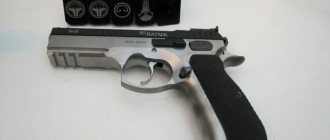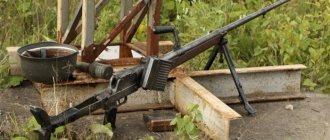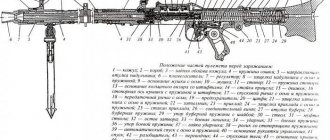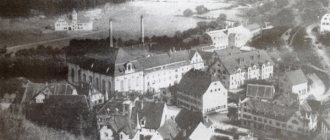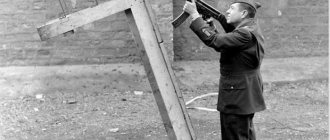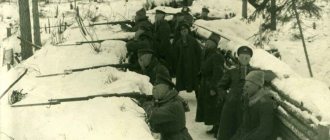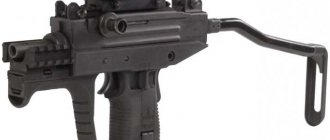| M1 Carbine | |
| M1 Carbine and M1A1 Carbine | |
| Type | self-loading carbine |
| A country | USA |
| Service history | |
| Years of use | July 1942 - 1960s (USA) |
| In service | USA and allies, Israel, Norway, South Vietnam, Brazil. South Korea |
| Wars and conflicts | World War II, Korean War, Malaya War, Vietnam War |
| Production history | |
| Constructor | David Williams[en] |
| Designed by | 1938-1941 |
| Manufacturer | Winchester Firearms Co., General Motors Corp., Inland Manufacturing Division, Saginaw Steering Gear Division, Underwood-Elliot-Fisher Co., National Postal Meter Co., Quality Hardware & Machine Co., International Business Machines Corp., Standard Products Co. , Rock-Ola Co. |
| Years of production | September 1941 - August 1945 |
| Total issued | more than 6.25 million |
| Options | See options |
| Characteristics | |
| Weight, kg | 2.36 (without ammo) |
| Length, mm | 904 (648 mm - with stock folded, for M1A1) |
| Barrel length, mm | 458 |
| Cartridge | 7.62×33 mm (.30 Carbine) |
| Caliber, mm | 7,62 |
| Work principles | removal of powder gases, rotary bolt |
| Rate of fire, rounds/min | single shooting (M1/A1); 750—770 (M2/M3) |
| Initial bullet speed, m/s | 600 |
| Sighting range, m | 275\300 yards\ |
| Type of ammunition | box magazine for 15 or 30 rounds |
| Media files on Wikimedia Commons | |
This term has other meanings, see.
M1 Carbine
(full name -
US Carbine, Caliber .30, M1
) - American light self-loading carbine during World War II.
In Russian literature, the M1 Carbine is sometimes mistakenly called “baby Garand” or “Garand carbine,” but such names are not found in American sources[1]. However, the nickname "Baby Garand" for this carbine is even found in US War Department documents.
History[edit | edit code]
In 1938, the US Army first thought about the need to re-equip the so-called “second line” military personnel (crews of combat vehicles not participating in infantry combat, gun crews and other soldiers who are not entitled to a “full-fledged” rifle) from self-loading pistols to light carbines . The reason for this was the greater efficiency of carbines, lower costs of training soldiers to use them effectively (compared to pistols), and, at the same time, rather small weight and size characteristics. Such ideas are consonant with the modern concept of PDW ( "personal self-defense weapon for military personnel"
).
In 1941, at the request of the US Army, a new .30 Carbine cartridge (7.62x33 mm) was developed, similar in its power and design to the magnum revolver (and subsequently it was actually used in a number of revolvers). Due to its high power by the standards of pistol ammunition, this cartridge is sometimes even considered transitional to intermediate, but in fact, although its muzzle energy (about 1200 J) was indeed much, approximately twice, higher than that of the then popular army pistol cartridges, everything however, it remained significantly lower than that of the “real” intermediate ammunition that appeared later (usually having a muzzle energy of about 2000 J in this caliber), and did not exceed the indicators of the magnum-class pistol and revolver cartridges popular in the USA (although, for example, one of currently used intermediate cartridges 5.45x39 have a muzzle energy of 1100-1500 J, which is quite close to the performance of 7.62x33) In addition, its short bullet with a round nose had rather mediocre ballistics, quickly losing speed, which also does not allow direct comparison with intermediate cartridges, which are equipped with sharp-nosed bullets designed for firing at relatively long ranges. In general, however, it is difficult to give an unambiguous definition of the class of this cartridge; apparently, the most correct designation is the one that was given to it when it was put into service - “Carbine”
, according to the only (at that time) type of weapon in which it was used, and for which it, in fact, was designed.
For this new cartridge by Winchester
A lightweight self-loading carbine was also developed.
Its design was based on a gas engine design developed by David Williams. M1 compared to the Garand rifle.
It was an elegant weapon, similar to a light hunting self-loading carbine. The carbine was short, convenient and easy to handle, weighed only 2.6...2.8 kg when loaded - that is, it was significantly lighter than submachine guns of that time; in extreme cases it could be fired with one hand, like a pistol. Despite the “form factor” of a full-fledged light carbine with a wooden stock, in essence it was a pistol-carbine, similar in purpose and characteristics to such classic examples of this class as the Mauser C96 or the artillery Luger.
Entering the active army in 1941, when the United States had already entered World War II, the M1 carbines quickly gained enormous popularity. The M1 Carbine resembled a smaller version of the "full-size" M1 Garand rifle, which was the main weapon of the American infantry, due to a number of similarities in design and design. The M1 was successfully used in close combat, surpassing any submachine guns of that time in accuracy and accuracy of single fire thanks to a lightweight bolt that locked during firing instead of a massive free one and a hammer-operated firing mechanism instead of firing “from the rear sear.” The soft (compared to rifles) recoil could provoke frequent shooting, however, American soldiers did not have problems with a shortage of ammunition[2]. True, the target firing range from the carbine did not exceed 275 m, which was primarily due to the unsuccessful shape of the bullet from a ballistics point of view.
In 1944, the M2 Carbine appeared, which was distinguished by the presence of a self-timer in the trigger mechanism, allowing firing in bursts, a fire type translator on the left side of the receiver, and a sector magazine with a capacity of 30 rounds. It is likely that its appearance was a response to the use of the StG-44 by the Germans - in any case, the chronology of events allows us to come to this conclusion. At the same time, most of the M2 carbines were obtained not by production, but in the field, by installing a special set of parts on existing M1s (set designations - T17 and T18). Meanwhile, the effectiveness of automatic fire from such a light weapon, even with a moderate cartridge power, turned out to be low, in addition, its firing had a negative impact on the durability of the weapon, so the M2 did not become as widespread as its prototype - about 600 thousand copies were produced , including those converted from M1.
During the Korean War, the M2 Carbine occupied the assault rifle niche. The ogival nose of the bullet provided good stopping effect at short distances. However, automatic fire from such a light weapon resulted in too much muzzle flip, which made long-range shooting useless. Overall, the M2 Carbine was noticeably inferior to submachine guns in its ability to control continuous fire. Due to bullet ballistics, single shot fire did not reach the accuracy of an M1 Garand rifle. In addition, in frosty weather, the carbine’s automatic system did not work perfectly [3].
They tried to convert both the M1 and M2 carbines into a sniper version. The M1E7 carbine with an optical sight was not successful. Based on the M2, we made an M3 carbine with a mount for the Sniperscope illuminated night sight in place of the standard open one. To reduce the illumination of the sight by the flash of a shot, the carbine was equipped with a flash suppressor. Only 2100 pieces were produced. On about. Okinawa in early 1945, riflemen using night sights allegedly killed up to 30% of the Japanese killed in all firefights.
Rifles, carbines, shotguns
M1 Carbine (USA)
M1 Carbine (full name - US Carbine, Caliber .30, M1) is an American light military self-loading carbine from the Second World War.
In 1938, the US Army first thought about the need to re-equip the so-called “second line” military personnel (crews of combat vehicles not participating in infantry combat, gun crews and other soldiers who are not entitled to a “full-fledged” rifle) from self-loading pistols to light carbines . The reason for this was the greater efficiency of carbines, lower costs of training soldiers to use them effectively (compared to pistols), and, at the same time, rather small weight and size characteristics. Such ideas are consonant with the modern concept of PDW (“personal self-defense weapon for military personnel”).
In 1941, at the request of the US Army, a new .30 Carbine cartridge (7.62x33 mm) was developed, similar in its power and design to the magnum revolver (and subsequently it was actually used in a number of revolvers). Due to its high power by the standards of pistol ammunition, this cartridge is sometimes even considered transitional to intermediate, but in fact, although its muzzle energy (about 1200 J) was indeed much, approximately twice, higher than that of the then popular army pistol cartridges, everything however, it remained significantly lower than that of the “real” intermediate ammunition that appeared later (usually having a muzzle energy of about 2000 J in this caliber), and did not exceed the indicators of the magnum-class pistol and revolver cartridges popular in the United States. In addition, its short round-nosed bullet had rather mediocre ballistics, quickly losing speed, which also does not allow direct comparison with intermediate cartridges that are equipped with sharp-nosed bullets designed for firing at relatively long ranges. In general, however, it is difficult to give an unambiguous definition of the class of this cartridge; apparently, the most correct designation was the one that was given to it when it was adopted - “Carbine”, based on the only (at that time) type of weapon in which it was used and for which it was, in fact, designed.
Winchester also developed a lightweight self-loading carbine for this new cartridge. Its design was based on a gas engine design developed by David Williams.
It was an elegant weapon, similar to a light hunting self-loading carbine. The carbine was short, convenient and easy to handle, weighed only 2.6...2.8 kg when loaded - that is, it was significantly lighter than submachine guns of that time; in extreme cases it could be fired with one hand, like a pistol. Despite the “form factor” of a full-fledged light carbine with a wooden stock, in essence it was a pistol-carbine, similar in purpose and characteristics to such classic examples of this class as the Mauser C96 or the artillery Luger.
Entering the active army in 1941, when the United States had already entered World War II, the M1 carbines quickly gained enormous popularity. The M1 received the affectionate nickname “baby Garand”, in honor of the “full-size” M1 Garand rifle, which at the same time was the main weapon of the American infantry, a smaller version of which it slightly resembled in appearance due to a number of common features in design and design. The M1 was successfully used in close combat, surpassing any submachine guns of that time in accuracy and accuracy of single fire thanks to a lightweight bolt that locked during firing instead of a massive free one and a hammer-operated firing mechanism instead of firing “from the rear sear.” True, the target firing range from the carbine did not exceed 200-300 m, which was primarily due to the unsuccessful shape of the bullet from a ballistics point of view.
In 1944, the M2 Carbine appeared, which was distinguished by the presence of a self-timer in the trigger mechanism, allowing firing in bursts, a fire type translator on the left side of the receiver, and a sector magazine with a capacity of 30 rounds. It is likely that its appearance was a response to the use of the StG-44 by the Germans - in any case, the chronology of events allows us to come to this conclusion. At the same time, most of the M2 carbines were obtained not by production, but in the field, by installing a special set of parts on existing M1s (set designations - T17 and T18). Meanwhile, the effectiveness of automatic fire from such a light weapon, even with a moderate cartridge power, turned out to be low, in addition, its firing had a negative impact on the durability of the weapon, so the M2 did not become as widespread as its prototype - about 600 thousand copies were produced , including those converted from M1.
The M1 had a relatively simple design for its class, adapted for mass production and very technologically advanced by the standards of US industry. The weapon had a gas exhaust engine with a short (only about 8 mm) stroke of the gas piston, located under the barrel. When fired, the piston transfers energy to the bolt frame with a short energetic push; further operation of the automation occurs due to the inertia of the moving parts, as well as the residual gas pressure in the barrel bore acting on the bottom of the cartridge case. The bolt frame, together with the return spring, was located inside the forend under the barrel, outside the receiver, sliding the process located on the right along the step on its side outer surface, which made it possible to minimize the dimensions of the receiver itself, thereby reducing the total weight of the weapon. A process located on the right side of the bolt frame, combined with the cocking handle, directly carried out unlocking and locking and opening and closing the bolt using a shaped groove with a bevel. The bolt was locked by turning clockwise by two lugs behind the cutouts of the receiver.
The trigger mechanism is trigger. The weapon had a push-button safety on the front of the trigger guard, which locked the trigger and seared when the button was pressed; on later releases it was replaced with a lever, since the button could easily be confused with the same magazine release button located in front of it. The M2 had a fire type translator in the form of a vertical lever, located on the left side of the receiver in the area of the window for ejecting cartridges. The weapon did not have a full-fledged bolt stop, but the bolt frame, located in the extreme rear position, could be locked by pressing a button at the base of the cocking handle. The magazines could be loaded with 15-round clips, without the use of any additional devices - guides for installing the clips were on the magazines themselves.
Weapon parts were made mainly on metal-cutting machines, but by American standards the M1 was considered a fairly technologically advanced and inexpensive weapon to produce: each copy cost the army $45, despite the fact that the purchase price of the M1 Garand rifle was $85, the Thompson submachine gun was $209 at the beginning war and up to $45 towards the end, a Colt M1911 pistol - about $12. Over all the years of production, more than 6 million copies of the carbine were produced. In some places it is still used by the police and similar structures; in the USA, its production continues by several companies, already as a civilian weapon, often with certain differences in design and external design.
The carbine was relatively quickly and easily disassembled and assembled; for this it was necessary to loosen the screw on the stock ring (early releases had a continuous ring with a spring latch), move it forward, remove the weapon mechanism from the wooden parts of the stock, disconnect the trigger box held by a pin, remove the bolt frame and remove the shutter.
Some carbines used M8 rifle grenade launchers. Beginning in 1944, lugs appeared on carbine barrels to accommodate M4 bayonets.
In 1941-1945. M1 carbines were produced for the US armed forces at a significant number of enterprises of a number of American companies, including:
- Winchester Repeating Arms Company
- International Business Machines Corporation
- Rock-Ola Manufacturing Corporation
After the end of World War II, M1 carbines and their commercial variants were produced by several more weapons companies, including:
- Springfield Armory
- Howa Machinery Company Ltd. (at the military arsenal in Nagoya)
- "Auto-Ordnance"
- Chiappa Firearms (Italy)
Options:
- M1A1 - carbine for parachute units, with a folding metal butt; 150,000 units produced.
- M1A2 - M1 with modified sights, not mass-produced.
- M1A3 - M1A1 with a modified folding stock, not mass-produced.
- M2 Carbine Model 1944 - variant with the ability to fire automatically at a rate of 750 rounds per minute. Along with the M2 carbine, a new sector magazine with 30 rounds of ammunition was adopted, which is fully interchangeable with magazines with 15 rounds of ammunition.
- M3 Carbine - “sniper carbine”, a modification of the M2 automatic carbine, which consisted of installing mounts for infrared night sights, as well as a removable flash suppressor. The M3 carbine could be equipped with the first generation M1, M2 and M3 night sights. Approximately 3,000 units were produced.
- The M1 Enforcer is a post-war commercial civilian modification without a stock and with a shortened barrel.
- “Le MAG” is a commercial modification chambered for the 11.43 mm .45 Winchester Magnum cartridge, created in the early 1990s (designer Tim Le Gendre); in addition, instead of the standard wooden stock, a new one made of black plastic was installed on the carbines.
- in the 2000s, it released a series of replicas of the M1 carbine chambered for 7.62x33 mm:
- Auto-Ordnance AOM110 - WWII M1 replica with birch stock but no bayonet mount
- Auto-Ordnance AOM120
- in 2008, it released a new series of replicas of the M1 carbine chambered for 7.62x33 mm:
- Auto-Ordnance AOM130 - World War II M1 replica with walnut stock
- Auto-Ordnance AOM150 - an exact replica of the World War II M1A1 with a folding metal stock
- Auto-Ordnance AOM160 - “tactical modification” with a folding stock, stock and pistol grip, which are made of black plastic
- Citadel M1 Carbine - conversion version of the M1 chambered for the 9x19 mm "Parabellum" cartridge
- Citadel M1-22 - M1 conversion chambered for .22LR
- Chiappa M1-9 - modification of the M1 chambered for the 9x19 mm Parabellum cartridge, powered by 15-round magazines from the Beretta 92 pistol
Characteristics:
- Weight, kg: 2.36 (without cartridges)
- Length, mm: 904
- Barrel length, mm: 458
- Cartridge: 7.62×33 mm (.30 Carbine)
- Caliber, mm: 7.62
- Operating principles: removal of powder gases, rotary bolt
- Rate of fire
- shots/min: single shooting (M1/A1);
- 750—770 (M2/M3)
- Initial bullet speed, m/s: 600
- Sighting range, m: 200—300
- Type of ammunition: box magazine for 15 or 30 rounds
Device[edit | edit code]
The device of the M2 automatic carbine.
The M1 had a relatively simple design for its class, adapted for mass production and very technologically advanced by the standards of US industry. The weapon had a gas exhaust engine with a short (only about 8 mm) stroke of the gas piston, located under the barrel. When fired, the piston transfers energy to the bolt frame with a short energetic push; further operation of the automation occurs due to the inertia of the moving parts, as well as the residual gas pressure acting on the bottom of the cartridge case in the barrel bore. The bolt frame, together with the return spring, was located inside the forend under the barrel, outside the receiver, sliding the process located on the right along the step on its side outer surface, which made it possible to minimize the dimensions of the receiver itself, thereby reducing the total weight of the weapon. A process located on the right side of the bolt frame, combined with the cocking handle, directly carried out unlocking and locking and opening and closing the bolt using a shaped groove with a bevel. The bolt was locked by turning clockwise by two lugs behind the cutouts of the receiver.
The trigger mechanism is trigger. The weapon had a push-button safety on the front of the trigger guard, which locked the trigger and seared when the button was pressed; on later releases it was replaced with a lever, since the button could easily be confused with the same magazine release button located in front of it. The M2 had a fire type translator in the form of a vertical lever, located on the left side of the receiver in the area of the window for ejecting cartridges. The weapon did not have a full-fledged bolt stop, but the bolt frame, located in the extreme rear position, could be locked by pressing a button at the base of the cocking handle. The magazines could be loaded with 15-round clips, without the use of any additional devices - guides for installing the clips were on the magazines themselves.
Weapon parts were made mainly on metal-cutting machines, but by American standards the M1 was considered a fairly technologically advanced and inexpensive weapon to produce: each copy cost the army $45, despite the fact that the purchase price of the M1 Garand rifle was $85, the Thompson submachine gun was $209 at the beginning war and up to $45 towards the end, a Colt M1911 pistol - about $12. Over all the years of production, more than 6 million copies of the carbine were produced. In some places it is still used by the police and similar structures; in the USA, its production continues by several companies, already as a civilian weapon, often with certain differences in design and external design.
The carbine was relatively quickly and easily disassembled and assembled; for this it was necessary to loosen the screw on the stock ring (early releases had a continuous ring with a spring latch), move it forward, remove the weapon mechanism from the wooden parts of the stock, disconnect the trigger box held by a pin, remove the bolt frame and remove the shutter.
Some carbines used M8 rifle grenade launchers. Beginning in 1944, lugs appeared on carbine barrels to accommodate M4 bayonets.
Manufacturers[edit | edit code]
In 1941-1945. M1 carbines were produced for the US armed forces at a significant number of enterprises of a number of American companies, including:
- Winchester Repeating Arms Company
- IBM - International Business Machines Corporation
- Rock-Ola Manufacturing Corporation
After the end of World War II, M1 carbines and their commercial variants were produced by several more weapons companies, including:
- Springfield Armory
- Howa Machinery Company Ltd. (at the military arsenal in Nagoya)
- "Auto-Ordnance"
- Chiappa Firearms (Italy)
- Inland Manufacturing (USA)
Modifications[edit | edit code]
- M1A1
- carbine for parachute units, with a folding metal butt; 150,000 units produced. - M1A2
- M1 with modified sights, not mass-produced. - M1A3
- M1A1 with a modified folding stock, not mass-produced. - M2 Carbine
Model 1944 - variant with the ability to fire automatically at a rate of 750 rounds per minute. Along with the M2 carbine, a new sector magazine with 30 rounds of ammunition was adopted, which is fully interchangeable with magazines with 15 rounds of ammunition. - M3 Carbine
- “sniper carbine”, a modification of the M2 automatic carbine, which consisted of installing mounts for infrared night sights, as well as a removable flash suppressor. The M3 carbine could be equipped with the first generation M1, M2 and M3 night sights. Approximately 3,000 units were produced. - The M1 Enforcer
is a post-war commercial civilian modification without a stock and with a shortened barrel. - “Le MAG”
is a commercial modification chambered for the 11.43 mm .45 Winchester Magnum cartridge, created in the early 1990s (designer Tim Le Gendre); in addition, instead of the standard wooden stock, a new one made of black plastic was installed on the carbines[ 4]. - in the 2000s, it released a series of replicas of the M1 carbine chambered for 7.62x33 mm:
- Auto-Ordnance AOM110
- WWII M1 replica with birch stock but no bayonet mount - Auto-Ordnance AOM120
- in 2008 released a new series of replicas of the M1 carbine chambered for 7.62x33 mm[5]:
- Auto-Ordnance AOM130
- replica WWII M1 with walnut stock[5] - Auto-Ordnance AOM150
- an exact replica of the World War II M1A1 with a folding metal stock[5] - Auto-Ordnance AOM160
- “tactical modification” with a folding stock, stock and pistol grip, which are made of black plastic[5]
- (USA) released:
- Citadel M1 Carbine
- conversion version of the M1 chambered for the 9x19 mm "Parabellum" cartridge - Citadel M1-22
- M1 conversion chambered for .22LR
- released its own modifications[6]:
- Chiappa M1-9
- modification of the M1 chambered for the 9x19 mm Parabellum cartridge, powered by 15-round magazines from the Beretta 92 pistol - Chiappa M1-22
- modification of the M1 chambered for .22LR
- (USA) produces:
- M1 1944
- an exact replica of the World War II M1 with a Type 2 barrel and a 10-round magazine - M1 1945
- an exact replica of the World War II M1 with a bayonet mount and a 15-round magazine - M1 Jungle
- an exact replica of the World War II M1 with a conical flash hider and a 15-round magazine - M1 Scout
- modification of the M1 with a polymer stock, forend with Picatinny rail, conical flash suppressor and 15-round magazine - M1A1 Paratrooper
- an exact replica of the World War II M1A1 with a folding stock and a 15-round magazine - M30-C
- modern version of the M1 type EBR (Enhanced Battle Rifle) - T30 Sniper Carbine
- an exact replica of the “sniper” version of the M1 under the designation T3 from the Second World War[7]
M1 Carbine
This term has other meanings, see.
| M1 Carbine | |
| M1 self-loading carbine | |
| Type: | Carbine |
| A country: | USA |
| Service history: | |
| Years of operation: | July 1942 - 1960s (USA) |
| Used: | USA and allies, Israel, Norway, South Vietnam, Brazil. South Korea |
| Wars and conflicts: | World War II, Korean War, Vietnam War |
| Production history: | |
| Constructor: | John Garand and David Williams |
| Designed by: | 1938-1941 |
| Years of production: | September 1941 - August 1945 |
| Total released: | More than 6.25 million |
| Options: | M1A1, M1A2, M1A3, M2, M3 |
| Characteristics | |
| Weight, kg: | 2.36 kg (without cartridges) |
| Length, mm: | 904 mm |
| Barrel length, mm: | 458 mm |
| Cartridge: | 7.62×33 mm (.30 Carbine) |
| Caliber, mm: | 7.62 mm |
| Work principles: | Powder gas removal, rotary bolt |
| Rate of fire, rounds/min: | Semi-automatic shooting (M1/A1); 850–900 rounds per minute (M2/M3) |
| Initial bullet speed, m/s: | 600 |
| Sighting range, m: | 200–300 m |
| Type of ammunition: | 15 or 30 round box magazine |
M1 Carbine
is a World War II self-loading carbine designed by John Garand and David Williams. The carbine is based on the M1 Garand self-loading rifle, but chambered for the new .30 Carbine cartridge
.
In service[edit | edit code]
- USA - was in service with certain categories of US military personnel (mainly command staff, second-line military personnel and auxiliary units) and the US National Guard.
- Great Britain - 25.362 delivered under the Lend-Lease program during World War II https://www.webcitation.org/5w2uyAZkN?url=https://lend-lease.airforce.ru/documents/files/Part_3A_pages_1-26.pdf
- France - 96.983 delivered under the Lend-Lease program during World War II \ https://www.webcitation.org/5w2uyAZkN?url=https://lend-lease.airforce.ru/documents/files/Part_3A_pages_1-26.pdf \ and 155.356 under the military assistance program after its completion https://www.bavarianm1carbines.com/carbinesnara.html
- Germany - captured carbines entered service under the name Selbstladekarabiner 455(a)
- Republic of China - 361 delivered under military assistance programs from the United States during World War II and 115,948 in 1951-1968. https://www.bavarianm1carbines.com/carbinesnara.html
- Norway - after World War II, 98,267 carbines were received under the military assistance program from the United States https://www.bavarianm1carbines.com/carbinesnara.htm, they were used under the name Selvladekarabin M1
- Federal Republic of Germany - after the creation of the Bundeswehr, 34,192 carbines were received from the United States under the military assistance program https://www.bavarianm1carbines.com/carbinesnara.htm, self-loading M1s entered service under the name G54, and automatic M2 carbines under the name G55
- Japan - after the end of World War II, 3,994 carbines received from the United States under the military assistance program were transferred to the Japanese Self-Defense Forces \ https://www.bavarianm1carbines.com/carbinesnara.html \
- Panama - 917 M1 and M2 were in service with the Armed Forces of Panama until December 1989 https://www.bavarianm1carbines.com/carbinesnara.html, when during the US invasion of Panama all Panamanian armed forces were disarmed and disbanded[8]
- Ireland - A number were in the hands of IRA rebels who used these weapons to repulse a loyalist attack in the Short Strand, a Catholic enclave of the Protestant part of Belfast
Links
- https://www.weltkrieg.ru/weapons/Garand/
- https://www.gewehr.ru/2006/11/19/m1garand.html
- M1 on World-Guns.ru
| Modern US infantry weapons in service after the Korean War | |
| Pistols | Colt M1911 • M9/A1 • M11 • Mk 22 • Mk 23 • Mk 24 |
| Rifles and machine guns | M1 and Mk 2 • M1918 • M14 • M15 • M16 • XM22/E1 • XM106 • XM70 • XM8 • Mk 14 • Mk 16/17 Mod 0 (FN SCAR) • HK416 |
| Carbines | M1/M2 • XM177/E1/E2 and GAU-5/A • XM23 • Colt Model 653 • M231 • M4/A1/E2 • GUU-5/P • Mk 18 |
| Sniper rifles | M21 • M24 • M25 • M40 • M82 and M107 • M88 and Mk 15 • M110 • Mk 11 • Mk 12 • DMR • RC-50 • SAM-R • SDM-R |
| Submachine guns | • • Mk 24 (S&W Model 76) • MP5/K |
| Smoothbore weapons | Ithaca M37 • Remington 870 • Mossberg 500/590 • M1014 • XM26 |
| Machine guns | M2 series (M2, M3, M213, XM218, M296, GAU-10/A, GAU-15/A, GAU-16/A, GAU-18/A, GAU-21/A) • M60 series and Mk 43 • XM207/E1 and Mk 23 • M73/M219 • M85 • M240 series • M249 series and Mk 46 • XM262 • XM307 • XM312 • Mk 21 • EX 27 • Mk 48 |
| Non-automatic grenade launchers | M79 • XM148 • M203 • M234 • M320 • M32 • EX 41 • EX 13 |
| Automatic grenade launchers | M75/M129 • XM174 • Mk 19 • Mk 47 • XM109 |
| Other weapons | XM25 • M20A1/A1B1 • M67 • M72 series • M136 (AT4) • M141 • M202/A1 • Mk 153 • FIM-43 Redeye • FIM-92 Stinger • FGM-172 SRAW • |
| Ammo | 7, 62x33 mm • 5, 56x45 mm • 7.62x51 mm NATO (.308 Win) • .30-06 Springfield • 12.7x99 mm NATO (.50 BMG) • .300 Winchester Magnum • 9x19mm Parabellum • .45 ACP • 12 gauge |

